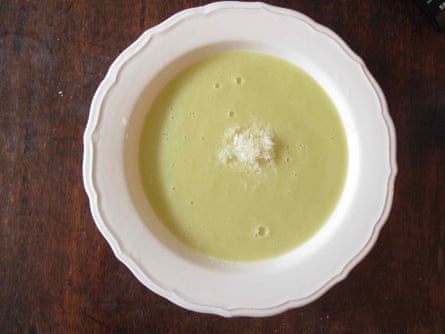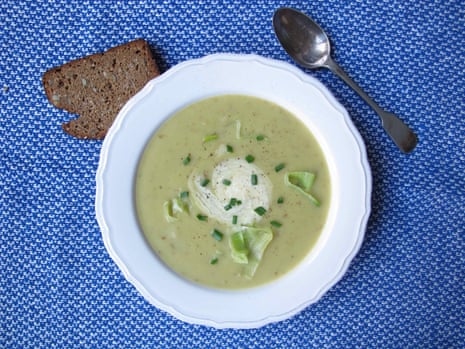The perfect soup for this time of year. Leeks are one of the few British greens available as we plunge into the so-called “hungry gap” between seasons, and bring with them a welcome freshness after all those earthily flavoured root veg. This version is an unchilled, continental vichyssoise, but an unapologetically hearty dish to warm the cockles in a British March – and, happily, just the thing to come home to after a bracing bank holiday walk.
The potatoes
As is often the case with dishes involving the humble spud, many recipes remain mysteriously silent on the specifics: only Nigel Slater and Paul Gayler’s Great Homemade Soups call for floury potatoes. In practice, waxy ones are a bit of a nuisance in this context, being slow to break down, and imparting a slightly gluey texture. Soup being a flexible, friendly kind of dish, if you’ve only got salad sorts in the house, the sky won’t fall in, but you’ll get a thicker, fluffier result from starchier spuds.

More important, in my opinion, is how you cook those potatoes – Gary Rhodes’ Great British Classics and Gayler leave the peel on (or, at least, don’t explicitly direct me to remove it), which means their soups taste of both the advertised ingredients, rather than just the leeks. Potatoes do have a flavour of their own, and it’s strongest in the skins, so it makes sense to leave these on, and saves time.
Best of all from a taste point of view, if you’ve got the oven on anyway, is a potato baked in its skin, as America’s Fine Cooking magazine suggests. Next time you make jacket potatoes, bake a couple of extra for the purpose – it’s well worth it. Boiling them in their own skins is a quicker, if slightly less flavourful option – if you want a fancy, dinner-party worthy soup, then strain it through a fine sieve, as Gayler recommends, to get rid of any less than elegant nut-brown specks.
Fine Cooking also stirs cooked, diced potato into the pureed soup, but this double whammy of starch seems a bit odd. One tester likens it to garnishing a baked potato with crisps; people do it, but that doesn’t make it right.

The leeks
The more stridently flavoured leek is simpler to deal with: use enough of them (and don’t discard the pungent green ends as some recipes suggest), and it’s hard to go wrong. That said, it’s important to saute them gently in plenty of butter without allowing them to brown – “or the special flavour … will be lost”, as Jane Grigson notes in her Vegetable Book. Simply simmering, as in Rhodes’ recipe, does not bring out the best in this lovely vegetable. I do very much like the silky strands of leek in his broth, however; he’s the only one not to puree his soup, and although a thicker, velvety texture is welcome at this time of year, it’s also pleasant to see some of the original ingredients, too. It’s a good idea to keep a few back to stir into the finished dish; not so with potato chunks, however – perhaps because the leeks contribute flavour, rather than body, to the puree.
Alliums
Rhodes, Grigson and Gayler add onions to their soups; Grigson and Fine Cooking go for garlic. Like Slater, however, I am going to eschew both, and allow the leek to take centre stage instead. It needs no help in the flavour department.

The liquid
With the exception of Grigson, who uses water, all the recipes call for the puree to be diluted with a light chicken or vegetable stock. Chicken is my default here, as every brand of vegetable stock I’ve tried (I know, but my freezer is too small to allow anything other than the occasional storage of homemade stuff) tastes pungently of dried herbs – and it gives the soup a savoury depth missing in Grigson’s recipe. That said, it’s still perfectly pleasant, so if you don’t have any stock, water makes a very decent substitute.
Dairy
The naturally creamy qualities of leek and potato soup are often enhanced with a dollop of dairy: Rhodes adds double cream, Gayler whole milk and double cream, and Fine Cooking whole milk and sour cream. Slater simmers his leeks with parmesan rinds to infuse the whole dish with an intensely savoury cheese flavour, while Fine Cooking melts in grated cheddar. Although these last two are undoubtedly delicious, my armchair critics agree that they would be hard pushed to identify the other ingredients in the soup, while Rhodes’ generous helping of double cream dulls the flavours instead. Sour cream gets the thumbs up from more of the testers, adding a welcome acidity that seems to accentuate, rather than bury, the leek and potatoes. I would prefer to deploy it as a garnish, rather than blending it into the soup itself – this should be a hearty dish, but not, I think, an overtly rich one.

Garnish
Grigson and Slater garnish their soups with parsley, but Gayler’s chives are better for echoing the flavour of the leeks. Fine Cooking tops its version with more cheese and sauteed bacon, which works well, but, in conjunction with the baked potato, risks relegating the leeks to a bit-part player. I am tempted by Slater’s suggestion, in a later recipe from his book Tender, of a few pieces of crumbled black pudding. An occasional treat, perhaps.

The perfect leek and potato soup
(serves 4)
1 or 2 large baking potatoes or 375g floury potatoes
2 large tbsp butter
450g trimmed leeks (about 3 medium)
1 litre light chicken or vegetable stock, or water
4 tbsp sour cream, to serve
4 tbsp chopped chives, to serve
Heat the oven to 200C (400F) fan. Prick the potato several times with a skewer, then bake for about an hour and a quarter until cooked through. Allow to cool slightly.
Meanwhile, melt the butter in a large saucepan over a gentle heat. Rinse the leeks, then roughly chop. Fry with a pinch of salt until soft and silky, then scoop out a couple of spoonfuls and set aside.
Cut the potato into cubes, skin and all. Add to the pan and saute for another couple of minutes, then add the stock or water. Bring to a simmer, then cook for 10 minutes.
Allow to cool slightly, then puree. Season to taste, then stir in the reserved leeks. Divide between bowls and top with a spoonful of sour cream and a sprinkle of chives.
Leek and potato: is it the perfect spring soup? How do you make yours, and how do you like to ring the changes when serving it cold as a fancy vichyssoise?

Comments (…)
Sign in or create your Guardian account to join the discussion